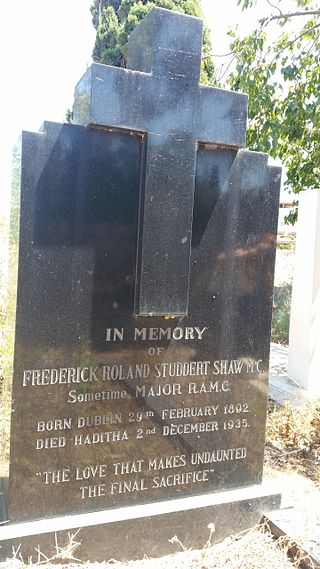Related Research Articles

Colonel William Alexander Camac Wilkinson, was a highly decorated British Army officer and English cricketer. Australian-born, he served with the British Army in both the First and Second World Wars. After the Second World War he spent some time in Graz, Austria, as Senior Military Government Officer in the occupation forces.
Rear-Admiral Gerald Cartmell Harrison was an English officer of the Royal Navy and a first-class cricketer.
Vice-Admiral Sir Alfred Englefield Evans was an English Royal Navy officer and first-class cricketer. Evans was a right-handed batsman who bowled right-arm medium pace. He rose to the rank of vice-admiral during his career, which involved service in the First World War.
Rear Admiral Charles la Primaudaye Lewin was a British rear admiral in the Royal Navy and an English cricketer. He was born in Greenwich, London.
Major Eric Tremayne Buller was an English cricketer and decorated British Army officer.
Ernest Augustus Fawcus was an English cricketer. Fawcus was a right-handed batsman who bowled with his right-arm, although his bowling style is unknown. He was born at Newcastle-upon-Tyne, Northumberland, and educated at Aldenham School and would later become a British Army and Royal Air Force officer. He died at Halton, Buckinghamshire, on 30 June 1966.

Frederick Roland Studdert Shaw was an Irish first-class cricketer and British Army officer.
Arthur Stanley Cantrell was an English first-class cricketer and Royal Marines officer. Cantrell was commissioned into the Royal Marine Artillery and served during the First World War. His military service with the Royal Marines lasted until his retirement in 1934, though he did later come out of retirement to serve in the Second World War. Cantrell also played first-class cricket for the Royal Navy Cricket Club between 1913–1929, making fourteen appearances.
Edward Arthur Aylmer was an English first-class cricketer and Royal Navy officer. He served in the Royal Navy from 1911–1945, seeing action in both the First World War and the Second World War. Reaching the rank of captain, he commanded several ships and establishments during his career. He also played first-class cricket for the Royal Navy Cricket Club.
Frederick Hugh Geoffrey Trumble was an English first-class cricketer and Royal Navy officer.
Frank Lankester Horsey was an English first-class cricketer and Royal Navy officer, serving as paymaster from 1905–39.
Clement Edward Glenister was an English first-class cricketer and Royal Navy officer.
Martin James Evans was an English first-class cricketer and Royal Navy officer.
Arthur Edward Hext Wright was an English first-class cricketer and Royal Navy officer.
Charles Neville Strode Smith was an English first-class cricketer and Royal Marines officer.
Surgeon Rear Admiral Arnold Ashworth Pomfret was an English first-class cricketer, ophthalmologist and Royal Navy officer.
Major-General Arnold Hughes Eagleton Reading was an English first-class cricketer and Royal Marines officer. He served in the Royal Marines from 1914–1946, rising to the rank of major-general, in addition to playing first-class cricket for the Royal Navy.
Rear Admiral Arthur Edmund Wood was an English first-class cricketer and Royal Navy officer.
Arthur Charles Barnby was an English first-class cricketer, who served as an officer in both the Royal Marines and the Royal Naval Air Service.
Godfrey John Arthur Murray Lyle Mulholland was an Irish first-class cricketer, civil servant, British Army officer and banking director.
References
- ↑ "Player profile: Arthur Skey" . CricketArchive. Retrieved 22 June 2019.
- ↑ Onwhyn, J. (1897). The Lancet. p. 80.
- ↑ "No. 26795". The London Gazette . 17 November 1896. p. 6273.
- ↑ "No. 27826". The London Gazette . 11 August 1905. p. 5548.
- ↑ "First-Class Matches played by Arthur Skey" . CricketArchive. Retrieved 22 June 2019.
- 1 2 "Army v Royal Navy, 1912" . CricketArchive. Retrieved 22 June 2019.
- ↑ "No. 29751". The London Gazette (Supplement). 15 September 1916. p. 9073.
- ↑ "No. 30227". The London Gazette (Supplement). 10 August 1917. p. 8208.
- ↑ "No. 33291". The London Gazette . 5 July 1927. p. 4324.